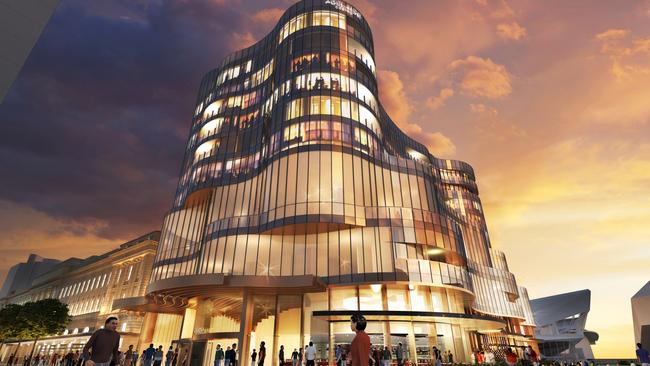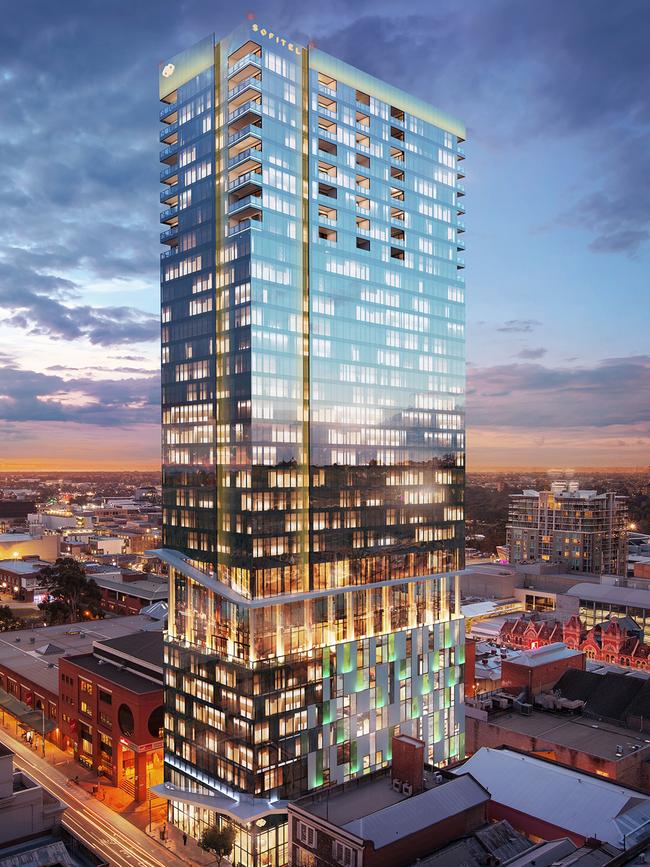The Riverbank Precinct is transforming day by day as new projects come to fruition
From a spark ignited in 2009, the Riverbank Precinct is glowing brighter than ever as its continuing transformation incorporates rich new development.
The heady days of the 1980s were in full swing when 3000 people gathered to celebrate the first stage of the reinvention of the Adelaide Railway Station and its former railyards.
In December 1985, the invitation-only opening of South Australia’s first casino, in the grand Railway Station building, doubled as a victory party for then premier John Bannon. His Labor Government had won a second term just five days before.
Flanked by chief justice Len King and police commissioner David Hunt, Bannon stood in the ring with the kip and tossed the pennies to begin the first-ever legal game of two-up in South Australia.
The guest list included businessman Sir James Hardy, jockey John Letts, cricketer David Hookes, opposition leader John Olsen (now Liberal Party state president) and Labor stalwarts Mick Young, the Port Adelaide federal MP, and deputy premier Don Hopgood.
It signalled a burst of activity in the rejuvenation of the River Torrens’ banks, now known as the Riverbank Precinct.
Less than two years later, in June 1987, Adelaide hosted the “dinner party of the decade” at the gala opening of Australia’s first purpose-built convention centre. The 1300 guests at the black-tie event dined on Port MacDonnell crayfish and “chicken Barossa”.
The Riverbank’s physical transformation had begun in 1973, when the Adelaide Festival Centre – Australia’s first multipurpose arts centre – was opened by the-then prime minister Gough Whitlam.
Just as there was more than a decade’s gap between the Festival Centre and Casino openings, Riverbank development stagnated amid the bleak financial climate in the aftermath of the 1991 State Bank disaster.
During the next two decades, there were tentative and ill-fated discussions about a cafe and retail strip along the Torrens’ southern bank, running west from the Festival Centre.
But these collapsed when developers, understandably, suggested a residential component to make the project viable.
It was not until late 2009, when the-then Labor Government announced Adelaide Oval’s $535 million upgrade, that the Riverbank Precinct started an overwhelming transformation that incorporated the Torrens’ banks.
The revamped Oval opened to widespread acclaim in 2014. A $40 million footbridge linked it to the southern bank, near the Adelaide Casino.
Seizing on the overwhelmingly positive vibe of the time, then premier Jay Weatherill spearheaded a successful drive to revitalise Adelaide’s CBD.
A particularly successful focus was promoting and legislating for small bars, which began proliferating around the city, further enhancing the atmosphere.
But the Adelaide Oval effect has not, as yet, triggered a proliferation of completed development in the Riverbank Precinct.

The most significant, thus far, has been the two-phase, $397 million redevelopment of Adelaide Convention Centre which opened in August last year.
Centre operators say the two new buildings boost plenary capacity to 3500 people and increase the overall footprint to 20,000sqm of multipurpose space, enabling the venue to host much larger events and numerous smaller ones simultaneously.
But the precinct’s linchpin has become Sydney property tycoon Lang Walker’s Festival Plaza redevelopment, which includes a 24-storey office tower adjacent to Parliament House, underground car park and two-storey retail and entertainment complex.
After almost four years of talks, State Cabinet approved the project in May 2016, for a
$1 billion transformation of the prime Riverbank land opposite Adelaide Oval.
Weatherill had unveiled plans in 2015 for the $610 million plaza redevelopment, saying Walker Corp would invest $430 million and taxpayers $180 million. A $90 million Festival Centre upgrade involves closing over the plaza to create new entries and foyers.
The dilapidated underground car park has been the starting point for the redevelopment.
In 2015, Adelaide Casino released fresh plans for a $300 million expansion, centred on a luxury hotel.
Access to the revamped 1560-space underground car park, being redeveloped as part of the Festival Plaza project, was vital.
By February last year, the expansion was being delayed by a dispute over high-roller entry to VIP gaming rooms and final talks over the long-awaited deal for the underground Festival Centre car park.
At the time, it was understood South Australia required far more detail about VIP room entrants than other states, which some gamblers were reluctant to provide.
That month, Walker Corp struck a deal with Casino operator SkyCity to secure 750 of the 1560 spaces in the new and expanded Festival Centre car park.
In July last year, SkyCity announced it would spend up to $330 million on the Casino expansion, adding a luxury hotel, new VIP gaming facilities, three new bars and three additional signature restaurants.
The number of hotel rooms was increased from 89 to 123, adding an additional floor to plans for the expanded building.
Work on the expansion started earlier this year and is expected to be finished in 2020.
In September, Walker moved to quell disquiet about the pace of his Festival Plaza development by again declaring talks were well advanced to sign tenants.
Through a spokesman, he released pictures of the newly completed Festival Centre
car park demolition and said the project was “on track” to open in 2020, coinciding with the Casino expansion opening.
RISE AND RISE
Adelaide and South Australia’s burgeoning tourism numbers are attracting more and more high-end accommodation, both traditional and innovative in design.
Recent STR figures benchmarking hotels show Adelaide is now the nation’s fourth-best performing capital city market – behind Sydney, Melbourne and Perth – after overtaking Brisbane.

The first sods for the Sofitel development on Currie St were recently turned, while work on the $200 million Westin on the site of the General Post Office building overlooking Victoria Square is also soon to begin. Described as the “height of luxury”, the Westin is expected to be completed by 2022. Richard Crawford, senior director of hotel development, Australia, New Zealand and the Pacific for Marriott International, of which Westin is a part, says the hotel will bring tourists to Adelaide for its high-end accommodation alone.
“Adelaide is experiencing an exceptional period of growth, and our partnership with Greaton presented an outstanding opportunity to introduce the Westin brand to the city and establish an important strategic presence for Marriott International,” he says. “From experience, we know the Westin name will attract new travel markets to the city. The brand enjoys a particularly loyal following and The Westin Adelaide will be a key offering to our 110 million global loyalty members.”
South Australian Tourism Industry Council chief executive Shaun de Bruyn says the state and Adelaide are now firmly on the global radar for hotel brands.
“We have always had good standards of accommodation here in Adelaide but they are getting better,” he says. “Adelaide and South Australia are now a real destination. We are sticking and really capitalising on our competitive advantages. People are coming and seeing the food and wine that we can offer.”
Martin Radcliffe, general manager of one of those hotels leading the way – the Mayfair Hotel on King William St – says offering service excellence is key.
So thorough has the Mayfair been regarding this, they recently won an award for the most comfortable bed in Australia.
“We tested a lot of beds before we selected them,” he says. “Adelaide has to be good at its service; it has to be good at the little things.”
The high-end explosion isn’t just confined to Adelaide. In August, Escapod installed its first prefabricated luxury accommodation pod at the Vineyard Retreat in McLaren Vale.
Ryan Brown, the founder of the company, says he plans to roll out 20 more across regional South Australia by June next year.
“I felt, regionally, we lacked high-end accommodation, especially for people who want something a bit more contemporary,” he says.
“Since we launched in August, we have been getting inquiries every day from around the country, but we are trying to focus on our backyard in South Australia. We are looking at installations on Kangaroo Island, in the Barossa, Coonawarra, the Flinders Ranges, Adelaide Hills and the Yorke Peninsula. I think the more high-end accommodation options we can supply for travellers, it will create more sustained tourism in our regional areas.”

